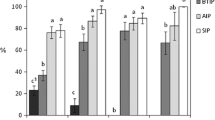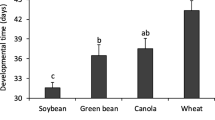Abstract
Sap-sucking sessile insects depend on their selected host plant for their development; hence, they are influenced by the nutritional quality of the plant, especially the available nitrogen (N) and water content in the plants. The levels of N in the plant sap can vary as function of the N fertilization applied to enhance crop yield, while deficit of water takes place during drought periods. The performance of the striped mealybug on cotton plants subjected to N fertilization and water stress (=deficit of water) was evaluated. Potted cotton plants grown in a greenhouse were subjected to N fertilization and two irrigation regimes considering regular irrigation and water stress. Cotton plants were infested with 150 newly hatched nymphs. The survival was measured as the percentage of mealybugs alive 25 days after infestation. The biological traits of duration of development + the pre-reproductive period, and the number and sex ratio of the offspring were determined. The survival of nymphs was similar across all treatments and averaged 38 %. Likewise, the developmental times were similar across treatments averaging 47 days, with 84 % of female offspring. However, offspring production was nearly twofold higher for water-stressed plants with successive N fertilizations. Offspring production was increased by 37 % as a function of water stress, and by 18 % as a function of N fertilization. Therefore, we conclude that the striped mealybug performance is enhanced on cotton plants under N fertilization and water stress. Based on the results, proper fertilization and irrigation management relieving plant from stress can be helpful in avoiding generalized infestations of striped mealybug on cotton.

Similar content being viewed by others
References
Aqueel MA, Leather SR (2011) Effect of nitrogen fertilizer on the growth and survival of Rhopalosiphum padi (L.) and Sitobion avenae (F.) (Homoptera: Aphididae) on different wheat cultivars. Crop Prot 30:216–221
Archer TL, Bynum ED Jr, Onken AB, Wendt CW (1995) Influence of water and nitrogen fertilizer on biology of the Russian wheat aphid (Homoptera: Aphidae) on wheat. Crop Prot 14:165–169
Barros R, Degrande PE, Fernandes MG, Nogueira RF (2007) Efeitos da adubação nitrogenada em algodoeiro sobre a biologia de Aphis gossypii Glover (Hemiptera: Aphididae). Neotrop Entomol 36:752–758
Bastos CS, Almeida RP, Vidal Neto FC, Araújo GP (2007) Ocorrência de Planococcus minor Maskell (Hemiptera: Pseudococcidae) em algodoeiro no Nordeste do Brasil. Neotrop Entomol 36:625–628
Bentz JA, Reeves JIII, Barbosa P, Francis B (1995) Within-plant variation in nitrogen and sugar content of poinsettia and its effects on the oviposition pattern, survival, and development of Bemisia argentifolii. Environ Entomol 24:271–277
Brodbeck B, Strong D (1987) Amino acid nutrition of herbivorous insects and stress to host plants. In: Barbosa P, Schultz J (eds) Insect outbreaks: ecological and evolutionary perspectives. Academic Press, San Diego, pp 347–364
Calatayud PA, Polanía MA, Seligmann CD, Bellotti AC (2002) Influence of water-stressed cassava on Phenacoccus herreni and three associated parasitoids. Entomol Exp Appl 102:163–175
Chen Y, Ruberson JR, Olson DM (2008) Nitrogen fertilization rate affects feeding, larval performance, and oviposition preference of the beet armyworm, Spodoptera exigua, on cotton. Entomol Exp Appl 126:244–255
Fennah RT (1959) Nutritional factors associated with the development of mealybugs in cacao. Rep Cacao Res InstTrinidad 1957–1958:18–28
Ferreira ECB, Silva CAD, Viana DL, Sousa SL (2009) A diversidade genética existente entre cultivares de algodão influencia de forma diferente populações de Phenacoccus solenopsis (Hemiptera: Pseudococcidae)? In: IV Encontro de Produção Científica da Embrapa Algodão – EPC. Campina Grande, Centro Nacional de Pesquisa de Algodão, pp 14
Gershenzon J (1984) Changes in the levels of plant secondary metabolites under water and nutrient stress. Recent Adv Phytochem 18:273–320
Grasswitz TR, James DG (2008) Movement of grape mealybug, Pseudococcus maritimus, on and between host plants. Entomol Exp Appl 129:268–275
Hogendorp B, Cloyd RA, Swiader JM (2006) Effect of nitrogen fertility on reproduction and development of citrus mealybug, Planococcus citri Risso (Homoptera: Pseudococcidae), feeding on two colors of coleus, Solenostemon scutellarioides L. Codd. Environ Entomol 35:201–211
Hsiao TC (1973) Plant responses to water stress. Annu Rev Plant Physiol 24:519–570
Huberty AF, Denno RF (2004) Plant water stress and its consequences for herbivorous insects: a new synthesis. Ecology 85:1383–1398
Huberty AF, Denno RF (2006) Consequences of nitrogen and phosphorous limitation for the plant performance of two plant hoppers with divergent life-history strategies. Oecologia 149:444–4556
Inbar MI, Doostdar H, Mayer RT (2001) Suitability of stressed and vigorous plants to various insect herbivores. Oikos 94:228–235
Jadoskil SO, Saito LR, Prado C, Lopes EC, Sales LLSR (2010) Characteristics of the Nitrate leaching in intensive farming areas. Pesqui Apl Agrotec 3:201–210
Jansson RK, Leibee GL, Sanchez CA, Lecrone SH (1991) Effects of nitrogen and foliar biomass on population parameters of cabbage insects. Entomol Exp Appl 61:7–16
Jiao X, Wang WXS, Wu Q, Zhou L, Pan H, Liu B, Zhang Y (2012) Host preference and nymph performance of B and Q putative species of Bemisia tabaci on three host plants. J Pest Sci 85:423–430
Kerpel SM, Soprano E, Moreira GRP (2006) Effect of nitrogen on Passiflora suberosa L. (Passifloraceae) and consequences for larval performance and oviposition in Helconius eratophyllis (Fabricius) (Lepidoptera: Nymphalidae). Neotrop Entomol 35:192–200
Larsson D (1989) Stressful times for the plant stress-insect performance hypothesis. Oikos 56:277–283
Lema KM, Mahungu NM (1983) Effects of fertilizer applications on postembryonic development and reproduction of the cassava mealybug. In: Proceedings of the second triennial symposium of the international society for the tropical root crops. Africa Branch, Douala, Cameroon, pp 231
Mattson WD (1980) Hebivory in relation to plant nitrogen content. Annu Rev Ecol Syst 11:119–161
Mattson WJ, Haack RA (1987) The role of drought in outbreaks of plant-eating insects. Bioscience 37:110–118
Miles PW, Aspinall D, Rosenberg L (1982) Performance of the cabbage aphid, Brevicoryne brassicae (L.), on water-stressed rape plants, in relation to the changes in their chemical composition. Aust J Zool 30:337–345
Miranda JE, Nascimento VL, Tripode BM, Abreu TPF, Anjos DE (2011) Suscetibilidade de Phenacoccus solenopsis a inseticidas. In: 8° Congresso Brasileiro de Algodão, 1° Cotton Expo, São Paulo. Evolução da cadeia para construção de um setor forte: Anais. Campina Grande, Embrapa Algodão, pp 274–280
Nelson-Rees WA (1960) A study of sex predetermination in the mealybug Planococcus citri (Risso). J Exp Zool 144:111–137
Nevo E, Coll M (2001) Effect of nitrogen fertilization on Aphis gossypii (Homoptera: Aphididae): variation in size, color, and reproduction. J Econ Entomol 94:27–32
Normark BB, Johnson NA (2011) Niche explosion. Genetica 139:551–564
Oliveira MD, Barbosa PRR, Silva-Torres CSA, Torres JB (2013) Performance of the striped mealybug Ferrisia virgata Cockerell (Hemiptera: Pseudococcidae) under variable conditions of temperature and mating. Neotrop Entomol 43:1–8
Oliveira MD, Silva-Torres CSA, Torres JB, Oliveira JEM (2014) Population growth and within-plant distribution of the striped mealybug Ferrisia virgata (Cockerell) (Hemiptera, Pseudococcidae) on cotton. Rev Bras Entomol 58:71–76
Orlando Filho J, Zambello Jr E (1983) Diagnose foliar. In: Orlando Filho J (ed) Nutrição e adubação da cana-de-açúcar no Brasil. Piracicaba, IAA/Planalsucar, pp 125–152
Panizzi AR, Parra JRP (1991) Ecologia nutricional de insetos e suas implicações no manejo de pragas. São Paulo, Manole
Price PW (1991) Plant vigor and herbivore attack. Oikos 62:244–251
Price PW, Clancy KM (1986) Multiple effects of precipitation on Salix lasiolepis and populations of the stem-galling sawfly, Euura lasiolepis. Ecol Res 1:1–14
Rae DJ, Jones RE (1992) Infuence of host nitrogen levels on development, survival, size and population dynamics of sugarcane mealybug, Saccharicoccus saccari (Cockerell) (Homoptera: Pseudococcidae). Aust J Zool 40:327–342
Ross L, Langenhof MBW, Pen I, Beukeboom LW, West SA, Shuker DM (2010) Sex allocation in a species with Paternal Genome Elimination: clarifying the role of crowding and female age in the mealybug Planococcus citri. Evol Ecol Res 12:89–104
Ross L, Dealey EJ, Beukeboom LW, Shuker DM (2011) Temperature, age of mating and starvation determine the role of maternal effects on sex allocation in the mealybug Planococcus citri. Behav Ecol Sociobiol 65:909–919
SAS Institute (2001) SAS/STAT User’s guide, version 8.02, TS level 2MO. SAS Institute Inc., Cary
Silva-Torres CSA, Oliveira MD, Torres JB (2013) Host selection and establishment of striped mealybug, Ferrisia virgata, on cotton cultivars. Phytoparasitica 41:31–40
Staley JT, Mortimer SR, Masters GJ, Morecroft MD, Brown VK, Taylor ME (2006) Drought stress differentially affects leaf-mining species. Ecol Entomol 31:460–469
Strickland AH (1950) The dispersal of Pseudococcidae (Hemiptera–Homoptera) by air currents in the Gold Coast. Proc R Entomol Soc Lond 25:1–9
Torres JB, Oliveira MD, Lima MS (2011) Cochonilhas farinhentas: potenciais problemas para o algodão brasileiro. Recife, Brasil, Universidade Federal de Pernambuco (Informativo REDALGO 005)
Varndell NP, Godfray HCJ (1996) Facultative adjustment of the sex ratio in an insect (Planococcus citri, Pseudococcidae) with paternal genome loss. Evolution 50:2100–2105
White TCR (1969) An index to measure weather-induced stress of trees associated with outbreaks of psyllids in Australia. Ecology 50:905–909
White TCR (1993) The inadequate environment: nitrogen and the abundance of animals. Springer, New York
Acknowledgments
This research was partially supported by the agencies “Fundação de Amparo à Ciência e Tecnologia do Estado de Pernambuco (FACEPE)” and the “Coordenação de Aperfeiçoamento de Pessoal de Nível Superior (CAPES)” through the projects APQ-0538-5.01/10 and PNPD No. 02544/09-1, respectively. Also, we would like to thank Alessandra Rung (Plant Pest Diagnostics Branch, California Department of Food and Agriculture, Sacramento, CA) and Douglas Miller (Systematic Entomology Laboratory, ARR-USDA, Beltsville, MD) for identifying the striped mealybug species.
Author information
Authors and Affiliations
Corresponding author
Additional information
Handling Editor: Joseph Dickens.
Rights and permissions
About this article
Cite this article
Oliveira, M.D., Barbosa, P.R.R., Silva-Torres, C.S.A. et al. Reproductive performance of striped mealybug Ferrisia virgata Cockerell (Hemiptera: Pseudococcidae) on water-stressed cotton plants subjected to nitrogen fertilization. Arthropod-Plant Interactions 8, 461–468 (2014). https://doi.org/10.1007/s11829-014-9320-5
Received:
Accepted:
Published:
Issue Date:
DOI: https://doi.org/10.1007/s11829-014-9320-5




